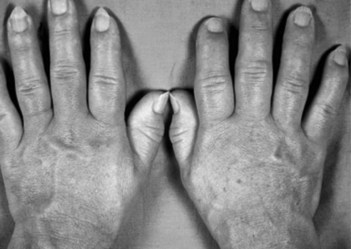142 Acromegaly
Salient features
History
• Ask the patient about old photographs of the patient for comparison
• Whether the patient has outgrown their wedding rings and shoes
• Headaches, visual field defects (depends on the size of the tumour)
• Paraesthesia and symptoms of carpal tunnel syndrome (p. 296)
• Oligomenorrhoea/amenorrhoea, galactorrhoea in females (prolactin is coproduced with growth hormone in approximately 40% of patients with acromegaly)
Examination
• On shaking hands there is excessive sweating: moist doughy, enveloping handshake.
• Large hands with broad palms, spatulate fingers; there is an increase in the ‘volume’ of the hands (Fig. 142.1).
• Look for evidence of carpal tunnel syndrome (tap over the flexor retinaculum for Tinel’s sign; see Fig. 76.1A).
• Prominent supraorbital ridges
• Protrusion of the lower jaw (prognathism); ask the patient to clench his teeth and note the malocclusion and splaying of the teeth (i.e. interdental separation)
• Ask the patient to show his tongue and look for macroglossia and for impressions of the teeth on the edges of the tongue (p. 829)
• For bitemporal hemianopia (p. 188) and optic atrophy
• Axillae for skin tags (molluscum fibrosum), acanthosis nigricans (black velvety papillomas)
• Chest for cardiomegaly, gynaecomastia and galactorrhoea
• Abdomen for hepatosplenomegaly
• Joints for arthropathy, i.e. osteoarthrosis, chondrocalcinosis
• Blood pressure for hypertension (present in 15% of cases)
• Tell the examiner that you would like to examine the urine for sugar (impaired glucose tolerance).
Advanced-level questions
What are the complications of acromegaly?
How would you investigate this patient?
What therapeutic options are available?
• Neurosurgical intervention, typically trans-sphenoidal, is the primary therapeutic choice for almost all patients. Diaphoresis and carpal tunnel syndrome often improve within 1 day of surgery. Although growth hormone levels fall immediately, insulin-like growth factor levels fall gradually.
• Radiation therapy is a primary treatment option for a few patients who have acromegaly but are not surgical candidates or when IGF-1 remains elevated after surgery because of residual tumour.
• The somatostatin receptor antagonist octreotide is valuable as adjunctive therapy to suppress growth hormone secretion while awaiting radiation. High doses of cabergoline (dopamine receptor antagonist) or treatment with somatostatin receptor ligands may improve the responsiveness to growth hormone in patients who otherwise have resistance to maximal doses of somatostatin receptor ligands
• Pegvisomant is a synthetic growth hormone receptor antagonist (the peptide is conjugated (pegylated) to polyethylene glycol to reduce renal clearance and immunogenicity) that lowers IGF-1 in >90% of patients, which is accompanied by clinical benefits (but no effect on tumour).
Mention other conditions with excess growth hormone secretion
• MEN type 1: parathyroid hyperplasia, pituitary tumours and gut tumours
• McCune–Albright syndrome: polyostotic fibrous dysplasia, sexual precocity and café-au-lait spots
• Carney complex is an autosomal dominant disorder that consists of multicentric tumours in many organs, including myxomas in heart, breast and testes; pigmented skin lesions; and pigmented nodular hyperplasia.








